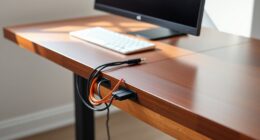If you’re looking for the best ergonomic mice of 2025 to boost comfort and productivity, I’ve found some great options. The Amazon Basics Wireless Mouse offers affordability and portability. Logitech’s Signature M650 L is perfect for larger hands with its customizable features. The Lift Vertical Mouse and Anker’s ergonomic design promote natural wrist positions, while the ProtoArc EM11 combines sleekness with multi-device support. Keep exploring—I’ll share more details to help you find the perfect fit.
Key Takeaways
- Prioritize mice with ergonomic shapes supporting natural hand posture to reduce fatigue during long hours.
- Choose models offering adjustable DPI and customizable buttons for personalized productivity.
- Opt for wireless options with long battery life and multiple connectivity modes for convenience.
- Match mouse size and grip style compatibility to ensure comfort for your hand size and usage habits.
- Consider surface compatibility and quiet operation features to enhance focus and reduce workspace disruptions.
Amazon Basics Wireless Computer Mouse

If you’re looking for an affordable, portable wireless mouse that’s easy to set up and use on the go, the Amazon Basics Wireless Computer Mouse is a solid choice. Its ergonomic design offers comfort for extended use, and its compact size makes it perfect for travel. With adjustable DPI settings, you can customize cursor sensitivity for different tasks. It operates on a single AA battery with automatic power-off to save energy. The mouse features forward/back buttons for easier navigation and tracks smoothly on various surfaces. Its simple plug-and-play setup and reliable 2.4 GHz connection make it a practical, budget-friendly option for everyday use.
Best For: casual users seeking an affordable, portable wireless mouse for everyday tasks, travel, and basic computer navigation.
Pros:
- Easy plug-and-play setup with no additional software required
- Compact, lightweight design ideal for travel and portability
- Adjustable DPI settings for customized cursor sensitivity
Cons:
- Small size may be uncomfortable for larger hands or extended use
- Durability concerns with some users experiencing mice failing after several months
- Ergonomic design is debated and may not provide adequate support for prolonged use
Logitech Wireless Mouse Signature M650 L for Large Hands

The Logitech Wireless Mouse Signature M650 L is the ideal choice for large-handed users seeking exceptional comfort and precise control. Its ergonomic design fits comfortably in the hand, with soft thumb areas and rubber grips that support prolonged use. The mouse connects seamlessly via Bluetooth or Logi Bolt USB receiver, compatible with Windows, macOS, Chrome OS, and Linux. It features an adaptive SmartWheel for smooth scrolling, silent clicks, and customizable side buttons for shortcuts. With a robust build and a 24-month battery life, it’s perfect for demanding work environments. Highly rated for reliability and comfort, the M650 L offers a practical, user-friendly experience for everyday productivity.
Best For: users with large hands seeking an ergonomic, reliable wireless mouse with long battery life and customizable features for everyday productivity.
Pros:
- Ergonomic design with soft thumb areas and rubber grips for long-lasting comfort
- Seamless dual connectivity via Bluetooth and Logi Bolt USB receiver, compatible with multiple OS
- Impressive 24-month battery life and silent clicks for quiet, reliable operation
Cons:
- Slightly heavier weight may not suit users preferring ultra-light mice
- Some users find the software for customization to be bulky or complex
- Limited advanced features compared to premium models like the MX Master series
Logitech Lift Vertical Ergonomic Mouse

Designed with comfort and versatility in mind, the Logitech Lift Vertical Ergonomic Mouse is ideal for users seeking to reduce wrist strain during long work sessions. Its unique 57-degree angle promotes a natural forearm position, easing fatigue. The softly textured grip and snug thumb rest enhance comfort, while its compact size fits small to medium hands, including taller users. Support for Bluetooth and Logi Bolt guarantees seamless connectivity across multiple devices, with customizable buttons for productivity. With up to 24 months of battery life and quiet, precise tracking, this mouse combines ergonomic benefits with reliability, making it a top choice for sustained, comfortable use.
Best For: users seeking an ergonomic, wireless mouse that reduces wrist strain and provides reliable multi-device connectivity for extended work sessions.
Pros:
- Ergonomically designed with a 57-degree angle promoting natural forearm posture.
- Long battery life of up to 24 months with replaceable batteries, reducing maintenance needs.
- Supports multiple connectivity options including Bluetooth and Logi Bolt, with seamless multi-device switching.
Cons:
- The compact size may not be suitable for users with larger hands or those who prefer a bigger mouse.
- Slightly higher price point around $70 compared to basic mice.
- Limited to four customizable buttons, which might be insufficient for users needing extensive shortcuts.
Anker Wireless Vertical Ergonomic Optical Mouse

For anyone experiencing wrist pain or seeking a more comfortable mouse, the Anker Wireless Vertical Ergonomic Optical Mouse stands out as an excellent choice. Its scientific ergonomic design promotes a neutral wrist and arm position, reducing strain during long work sessions. With adjustable DPI settings (800/1200/1600), it offers precise movement across different surfaces, and the silent scroll wheel enhances comfort. Compatible with Mac, Windows, and Linux, it connects wirelessly via 2.4G, supporting multi-device use. Despite a slight learning curve, users report significant relief from wrist discomfort. Its affordable price and 18-month warranty make it a practical, health-conscious option for improving ergonomics.
Best For: users experiencing wrist pain, seeking ergonomic comfort, or wanting a health-conscious, adjustable wireless mouse suitable for multi-device use.
Pros:
- Promotes neutral wrist and arm posture, reducing strain and discomfort
- Adjustable DPI settings (800/1200/1600) for precise control on various surfaces
- Compatible with multiple operating systems (Mac, Windows, Linux) and supports multi-device connectivity
Cons:
- Slight learning curve due to vertical design for new users
- Smooth surface may cause slipping, requiring grip adjustments or additional grip material
- Battery life can vary, with some users experiencing faster drain over time
ProtoArc Ergonomic Wireless Vertical Mouse (EM11 NL)

If you spend long hours at your computer and need a mouse that minimizes wrist strain, the ProtoArc EM11 NL stands out as an ideal choice. Its ergonomic vertical design promotes a natural handshake grip, reducing fatigue and discomfort. Suitable for small to medium hands, it offers precise fingertip control and a sleek, modern look. The mouse supports multi-device connectivity via Bluetooth 5.0 and 2.4GHz USB, with long battery life and quick pairing. Its quiet clicks and adjustable DPI (1000/1600/2400) enhance accuracy. Many users report significant wrist relief, making it a comfortable, reliable, and stylish option for extended use.
Best For: users seeking an ergonomic, wireless mouse that reduces wrist fatigue during long periods of computer use, especially those with small to medium hands.
Pros:
- Promotes natural wrist and forearm positioning, reducing fatigue and discomfort
- Supports multi-device connectivity via Bluetooth 5.0 and 2.4GHz USB with quick pairing
- Offers adjustable DPI settings (1000/1600/2400) for precise control and smooth responsiveness
Cons:
- Back and forward buttons are not programmable and may have limited compatibility with Mac OS
- Some users report issues with certain mousepads affecting functionality
- No battery life indicator, which could improve usability during extended use
Factors to Consider When Choosing Ergonomic Mice

When choosing an ergonomic mouse, I look at factors like hand size and grip style to guarantee comfort. Connection options matter too, whether I prefer wireless flexibility or a wired connection for reliability. Additionally, I consider design features and battery life to find a mouse that fits my work routine perfectly.
Hand Size Compatibility
Choosing the right ergonomic mouse starts with guaranteeing it fits your hand size comfortably. A properly sized mouse provides better support, reduces strain, and enhances control. If you have larger hands, look for a bigger mouse that offers full palm contact and natural support, helping you avoid overstretching your fingers. Conversely, if your hands are petite, opt for a smaller mouse to ensure precise movements without unnecessary effort. Pay attention to the mouse’s dimensions and weight, which are often listed by manufacturers, to confirm compatibility. The shape and contour should also match your natural hand curvature and grip style. Ultimately, selecting a mouse that aligns with your hand size helps promote comfort and minimizes fatigue during extended use.
Grip Style Suitability
The grip style you prefer plays a crucial role in selecting an ergonomic mouse that feels natural and comfortable. Whether you favor a palm, claw, or fingertip grip, each style influences the mouse design that will suit you best. Palm grip users typically benefit from larger, contoured mice that support the entire hand, promoting relaxation. Claw grip enthusiasts might prefer smaller, more responsive mice that allow for quick, precise movements with a slightly arched hand position. Fingertip grip users often need lightweight, compact mice that enable fine control with minimal effort. Choosing a mouse that aligns with your grip style ensures comfortable use over long periods, reduces fatigue, and improves overall productivity. Matching your grip style to the right design is essential for a truly ergonomic experience.
Connection Options Flexibility
Selecting an ergonomic mouse with the right connection options can substantially enhance your overall experience, whether you’re working, gaming, or browsing. Many models offer multiple connectivity choices, like Bluetooth, 2.4GHz wireless, or USB receivers, making it easy to adapt to different devices and setups. The ability to switch between wired and wireless modes lets you choose convenience or reliability based on your environment. Multi-device pairing support allows seamless switching across several computers or tablets without reconnecting. Compatibility with various operating systems, such as Windows, macOS, Linux, and Android, often depends on the connection type. Dual connectivity modes, like Bluetooth and wireless USB, increase versatility and ensure stable performance in diverse scenarios. This flexibility helps create a customizable, efficient workspace or gaming station.
Ergonomic Design Features
When considering ergonomic mice, focusing on design features that promote natural hand positions can make a considerable difference in comfort and health. Shapes that support the wrist and arm reduce strain during long hours of use. Vertical designs, contoured grips, and adjustable angles help maintain proper posture and minimize discomfort. Many models incorporate soft-touch materials, thumb rests, and textured surfaces to improve grip and comfort. Adjustable elements like DPI sensitivity and customizable buttons let you tailor the mouse to your ergonomic needs and workflow. The goal of these design features is to prevent repetitive strain injuries by encouraging neutral hand positions and reducing pressure points. Choosing a mouse with thoughtful ergonomic design can considerably enhance both comfort and productivity over time.
Battery Life Expectations
Have you ever experienced your ergonomic mouse dying right when you need it most? It’s frustrating and can disrupt your workflow. That’s why considering battery life expectations is essential. Longer battery life means fewer recharges or replacements, ensuring consistent ergonomic support during long work sessions. Many wireless ergonomic mice now offer rechargeable batteries that last several weeks or even months on a single charge. Some models include power-saving features like automatic sleep modes, which extend battery life when not in use. The type of batteries matters too—AA batteries or rechargeable USB-C options can impact convenience and longevity. To avoid interruptions, pick a mouse whose battery life aligns with your daily usage patterns, so you stay comfortable and productive without constant charging concerns.
Surface Compatibility Range
Battery life is just one factor to contemplate when choosing an ergonomic mouse; surface compatibility can markedly impact your overall experience. A mouse’s ability to track accurately on different surfaces matters, especially if your workspace includes glass, plastic, or textured desks. Optical mice tend to perform best on matte, non-glossy surfaces, while laser mice can often handle glass or highly reflective surfaces better. Some advanced models feature sensors capable of reliable tracking across multiple materials, reducing the need for a mouse pad. This consistency is vital for tasks requiring precision, like graphic design or CAD work. When selecting a mouse, consider your typical surfaces to ensure smooth, accurate tracking without frustration or interruptions, ultimately boosting your comfort and productivity.
Additional Customization Features
Choosing an ergonomic mouse with the right customization features can substantially boost your productivity and comfort. Programmable buttons let me assign shortcuts and functions, saving time and reducing repetitive movements. Adjustable DPI settings allow me to tweak cursor sensitivity for precise control or faster navigation, depending on the task. I also appreciate mice with adjustable scroll wheel modes, switching between line-by-line scrolling and free spin for smoother browsing. Being able to reconfigure or remap side buttons through dedicated software makes the mouse truly personal, fitting my workflow perfectly. Additional features like customizable lighting or profiles tailored to specific applications help optimize ergonomics and usability. These customization options enable a more intuitive experience, making my work more efficient and comfortable throughout long hours.
Frequently Asked Questions
Which Ergonomic Mouse Offers the Best Battery Life?
You’re asking about the best ergonomic mouse for battery life, which is essential for uninterrupted work. I’ve found that the Logitech MX Master 3S offers impressive longevity, often lasting up to 70 days on a single charge. Its fast-charging feature means just a few minutes can give you hours of use. If battery life is your priority, this mouse consistently stands out as a top choice for productivity without frequent recharging.
Are Wireless Ergonomic Mice More Reliable Than Wired Ones?
Think of wireless ergonomic mice as free spirits, soaring through the air, while wired ones are sturdy anchors. In my experience, wireless mice can be just as reliable, especially with modern Bluetooth technology and strong batteries. However, wired mice still hold an edge in consistent connectivity and zero lag. It really depends on your needs—if you value mobility, wireless is great; if stability is key, wired might be better.
How Do Ergonomic Mice Impact Wrist Health Long-Term?
When I use ergonomic mice, I notice a significant difference in my wrist health over time. They help reduce strain and prevent issues like carpal tunnel syndrome by supporting a natural hand position. Long-term, I’ve experienced less pain and fatigue, making my work more comfortable. I recommend trying one if you’re concerned about wrist health, as consistent use can promote better posture and prevent chronic problems.
Can Ergonomic Mice Be Used Effectively by Gamers?
You’re wondering if ergonomic mice work well for gaming, right? I’ve found they can be effective, especially with models designed for precision and comfort. While some gamers prefer traditional gaming mice, many ergonomic options offer customizable buttons and smooth tracking that suit gaming needs. If you choose the right one, you’ll enjoy reduced strain and improved control, making your gaming sessions more comfortable and enjoyable long-term.
What Is the Average Lifespan of a High-Quality Ergonomic Mouse?
While some might think high-quality ergonomic mice last forever, I’ve found they typically endure around 3 to 5 years with regular use. Like a reliable partner, they’re built to last but eventually show signs of wear. Proper care can extend their lifespan, but factors like usage intensity and maintenance matter. So, don’t be surprised if, after a few years, you start noticing performance dips.
Conclusion
Choosing the right ergonomic mouse is like finding the perfect dance partner—one that moves with your hand and keeps discomfort at bay. Whether you prefer a sleek design or a vertical grip, the options for 2025 are more diverse than ever. Invest in comfort today, and watch your productivity soar like a bird in free flight. After all, a well-chosen mouse turns every click into a smooth, effortless step forward.










